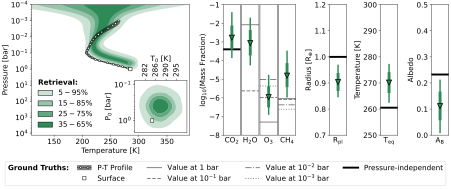Planetary Atmospheres
Atmospheric retrieval frameworks allow us to provide estimates of the main atmospheric and planetary parameters from a measured exoplanet spectrum. Using a Bayesian approach, the space of input parameters is explored iteratively to assess which combination of parameter values best explains the observed data.
Atmospheric retrievals are already widely used to characterize the atmospheres of Hot Jupiters and Brown Dwarfs from measured spectra. In contrast, the application of this technique to the spectra of habitable-zone (HZ) terrestrial exoplanets, which are the best candidates for hosting life as we know it, is less studied due to a lack of high-quality spectral measurements of such planets.
Although HZ terrestrial exoplanets are expected to be common, their limited brightness and size compared to their host star make detections and spectral measurements highly challenging with currently available instruments. While transit observations with the James Webb Space Telescope (external page JWST) are revealing if terrestrial exoplanets in the M-dwarf habitable zone (HZ) can have significant atmospheres, only the future ground-based extremely large telescopes (external page ELTs; e.g.) will be capable of directly measuring the spectra of terrestrial HZ exoplanets around the nearest stars. Yet, neither current or approved future instruments are capable of performing an in-depth atmosphere characterization for a large number of HZ terrestrial exoplanets. Thus, the exoplanet community is aiming to develop more capable observatories. NASA is working towards the large space-based Habitable Worlds Observatory (external page HWO), which will measure the host-star light reflected by the terrestrial exoplanet. In contrast, the Large Interferometer For Exoplanets (external page LIFE) is a space-based mid-infrared (MIR) nulling interferometer concept led by our group. LIFE aims to directly measure the thermal emission of terrestrial HZ exoplanets.
In our group, we use our own atmospheric retrieval framework to study simulated and real MIR spectra of Solar System planets and exoplanets. This allows us to:
1. Investigate how well terrestrial exoplanets can be characterized from different quality simulated LIFE observations (different wavelength coverages, noise-levels, and the spectral resolutions). This helps us determine the requirements LIFE needs to meet to characterize HZ terrestrial exoplanets.
2. Compare retrieval predictions to realistic ground truths and thereby study systematic errors in retrieval predictions. A robust understanding of such biases is crucial to the development of a reliable frameworks for the characterization of terrestrial exoplanets, the assessment of their habitability, and the detection of biosignatures. We further study new approaches to atmosphere parameterization to optimize our retrieval routine.
In several studies we have started to investigate these two points:
Publications:
- external page call_made Konrad et al. (2022): external pageBy running retrievals on synthetic Earth spectra, we derive first constraints for the minimal wavelength coverage, noise-level, and spectral resolution required for LIFE.
- external page call_made Alei et al. (2022a): external pageWe investigate if these minimal LIFE requirements suffice to characterize Earth at different stages of its temporal evolution with LIFE
- external page call_made Alei et al. (2022b): external pageWe discuss how changes to the retrieval setup can lead to systematic differences in retrieval results and thus affect our characterization.c
- external page call_made Angerhausen et al. (2023): external pageMotivated by the claimed detection of Phosphene (a potential biosignature) in Venus’ atmosphere, we study which cases of phosphene chemistry would be detectable with LIFE.
- external page call_made Konrad et al. (2023): We consider a simulated MIR Venus spectrum to investigate how clouds affect our retrieval characterization and whether they can be detected.
- external page call_made Gebhard et al. (2023): We present a novel learning-based method to parametrize atmospheric pressure-temperature structures in retrievals, which helps significantly improve retrieval results.
- external page call_made Mettler, Konrad et al. (2023): We run retrievals on real Earth spectra to investigate how factors such as the viewing angle (e.g., pole-on vs. equatorial view) affect our characterization. Further, by comparing retrieval predictions to the know ground truths, we study biases in our retrieval results (Figure 1).
- chevron_right • Alei et al. (in prep.): We investigate how well an Earth-like exoplanet can be characterized from combined observations with HWO and LIFE to demonstrate the complementarity of both observatories
With the knowledge we gain through our efforts, we aim to deliver insights that will help the community reliably identify habitable or even inhabited exoplanets with future observations from upcoming facilities.
